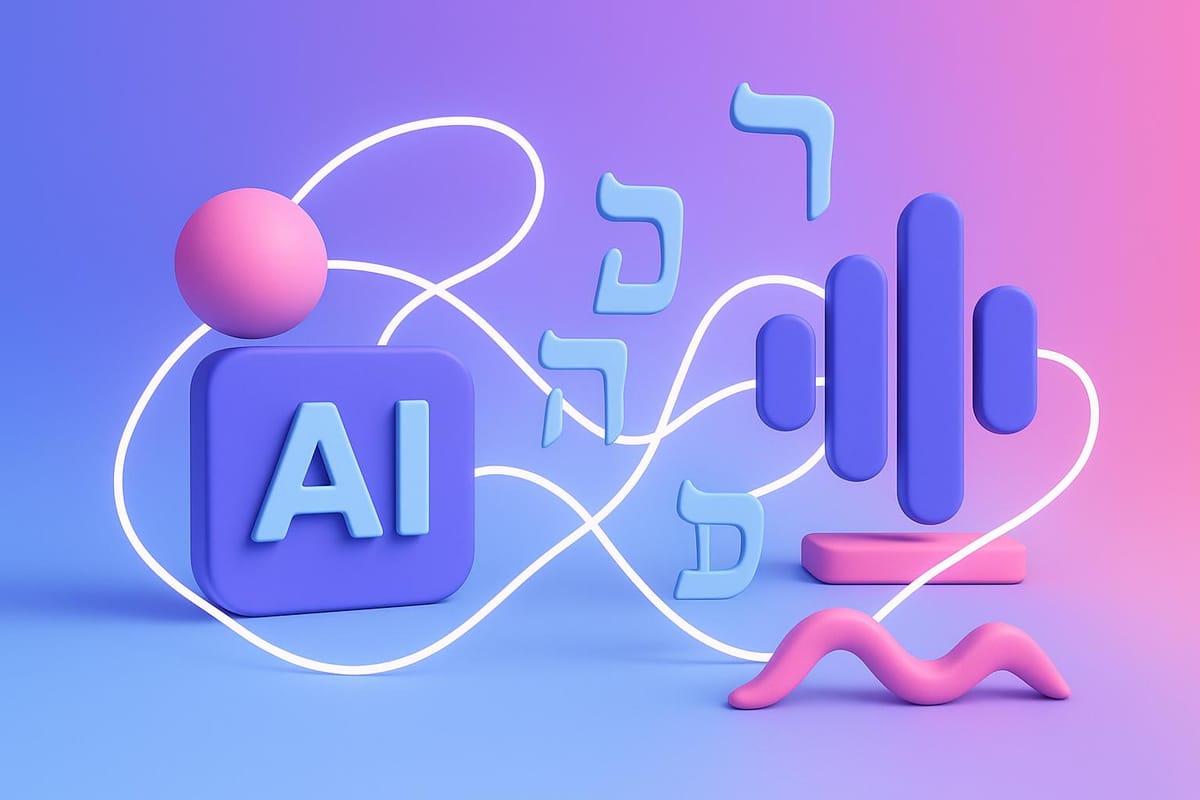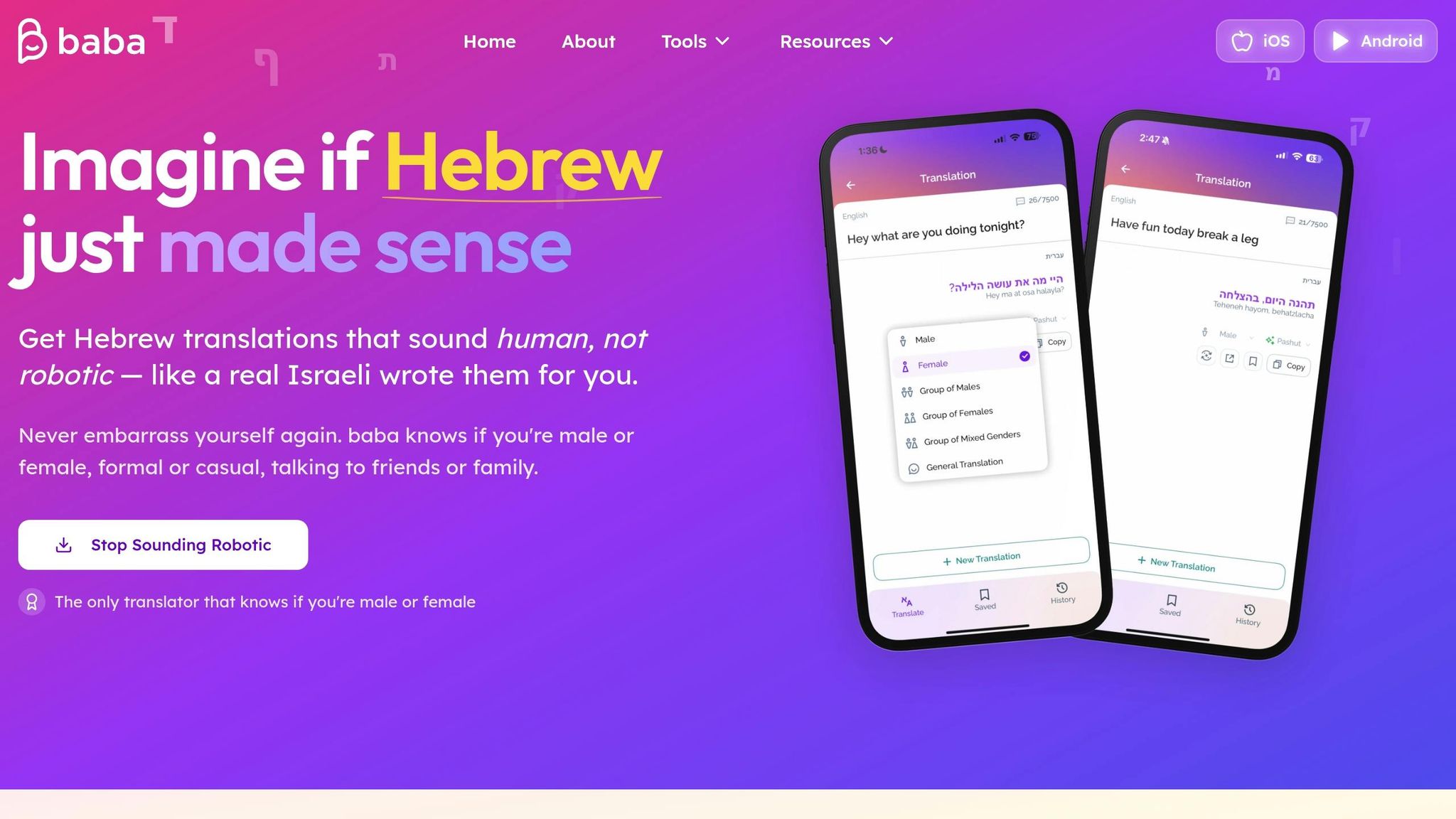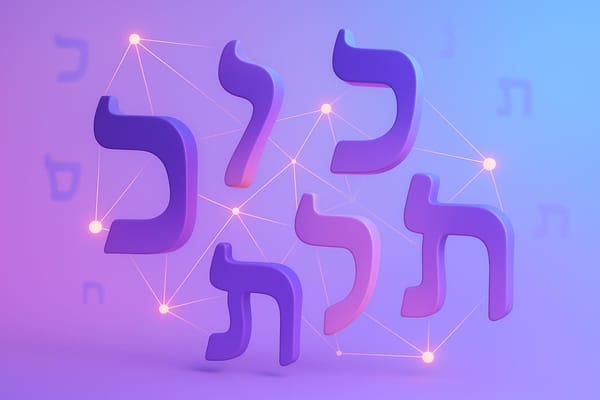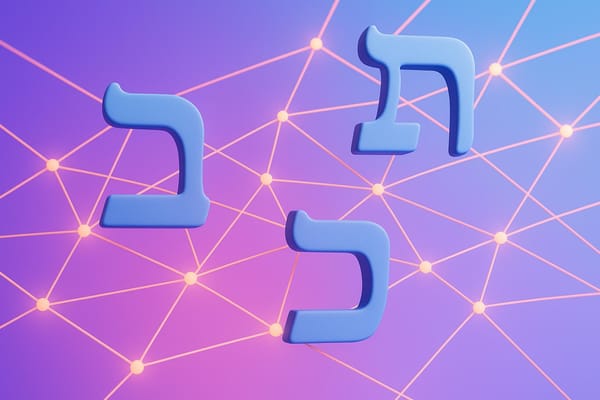How AI Translates Hebrew Audio to Text
Explore how AI transcription tools streamline Hebrew audio conversion while addressing the language's unique grammatical challenges.

AI transcription for Hebrew audio is faster and more accurate than ever, but it faces unique challenges. Hebrew's grammar, with gender-specific words, omitted vowels, and idiomatic expressions, makes transcription tricky. Tools like baba tackle these issues with specialized AI models that adapt to Hebrew's complexities and cultural context.
Key Steps for Hebrew Audio Transcription:
- Upload Audio: Use clear recordings in supported formats like MP3 or WAV.
- AI Processing: Advanced algorithms analyze Hebrew nuances, achieving up to 98.86% accuracy under ideal conditions.
- Review & Edit: Human review ensures accuracy, especially for idioms and speaker identification.
- Export Results: Save transcripts in formats like TXT or PDF.
Tips for Best Results:
- Record in quiet settings with a clear voice.
- Use tools designed for Hebrew to handle gender, grammar, and idioms.
- Always review for context and cultural accuracy.
Applications include: transcribing podcasts, documenting business meetings, and helping Hebrew learners improve language skills. Want to experience tailored Hebrew transcription? Join baba's mobile app waitlist at www.itsbaba.com.
How to do Free Speech-to-Text Transcription Better Than Google Premium API with OpenAI Whisper Model

How AI Converts Hebrew Audio to Text: Step-by-Step Process
Turning Hebrew audio into text using AI involves a series of well-coordinated steps, each designed to ensure the transcription is as precise as possible. Here's how it works:
Upload and Prepare Hebrew Audio Files
The process begins by uploading your Hebrew audio file to an AI transcription platform. Supported formats typically include WAV, MP3, M4A, CAF, and AIFF, with a common file size limit of 1GB. If your file exceeds this limit, you can compress it using audio editing tools without sacrificing quality. Be sure to select "Hebrew" as the transcription language - this helps the system apply processing algorithms tailored specifically to the Hebrew language, improving accuracy. For best results, use recordings made in quiet settings with minimal background noise.
Once the audio is uploaded, the AI starts analyzing the file to capture Hebrew speech patterns and nuances.
AI Processing of Hebrew Speech
After the upload, the AI system gets to work. It uses advanced algorithms, including signal processing, feature extraction, and pattern recognition, all fine-tuned for Hebrew's unique phonetics and grammar. Artificial neural networks further analyze the audio, identifying speech patterns specific to Hebrew. Thanks to extensive multilingual training, the system can accurately interpret Hebrew nuances. Under ideal conditions, the transcription accuracy can reach up to 98.86% for high-quality recordings. Automatic speech recognition (ASR) technology then converts the spoken words into text with impressive precision.
Review and Edit the Generated Text
While AI can produce highly accurate results, it's not foolproof. Misinterpretations can happen, so reviewing the transcript is essential. Listen to the audio while checking the text, paying close attention to speaker identification - especially in fast-paced conversations or when voices sound similar. Use timestamps to flag unclear sections, verify unfamiliar terms, and adjust playback speed for challenging segments, such as those with heavy accents or technical jargon. Many transcription platforms offer built-in tools like timestamps, speaker tags, and search functions to make editing more efficient [15–17].
Export and Save Your Transcript
Once you're satisfied with the transcript, you can export it in your preferred format. Common options include TXT, DOCX, and PDF, allowing you to choose the format that best suits your needs.
Want to stay ahead? Join the waitlist for our mobile app at www.itsbaba.com.
Tips for Better Hebrew Transcription Results
Getting precise Hebrew transcription results starts with clear audio recordings and using tools that are specifically designed to handle the unique aspects of the Hebrew language.
Record Clear Audio
Accurate transcription begins with high-quality audio. To achieve this, record in a quiet environment and position the microphone about a hand’s span away from your mouth, slightly off to the side. This setup reduces distortion and ensures clarity.
Using headphones to monitor audio levels can help you catch issues like distortion early. Speak clearly, at a natural pace, and consider using a pop filter to minimize harsh sounds caused by plosive consonants.
Before recording, warming up your voice can help maintain a steady tone and prevent cracking. This step is especially helpful for ensuring your Hebrew pronunciation is clear, which makes it easier for transcription tools to process your speech accurately. Once your audio is ready, the next step is choosing the right tools.
Use Gender- and Context-Aware Tools
Hebrew grammar is intricate, with its gendered nouns and verbs, which can pose challenges for standard transcription tools. To address this, opt for platforms like baba, which are specifically designed for Hebrew. These tools are capable of recognizing gender distinctions and contextual cues, ensuring more accurate transcriptions.
For example, baba understands whether the speaker is male or female and whether they’re addressing one person or a group. This capability allows it to make the right grammatical choices. Additionally, these tools are trained to interpret Hebrew idioms and expressions that might confuse general-purpose software, making the transcription more natural and reflective of Hebrew's nuances.
Check for Proper Context and Meaning
Even with advanced AI tools, human oversight is essential to ensure accuracy. Hebrew has many idiomatic expressions and unique phrases that don’t always translate literally, and AI tools might miss these subtleties.
Review the transcript carefully, especially for specialized terminology or cultural expressions. For critical documents, consider having a second person review the transcription to catch errors or misinterpretations. This step is particularly important for Hebrew, where context can heavily influence meaning.
Keep in mind that while high-quality audio can lead to transcription accuracy rates as high as 98.86%, factors like accents or dialects can still impact results. By combining these strategies with tools like baba, you can significantly improve your transcription outcomes.
Want to experience advanced Hebrew transcription tailored to your needs? Join the waitlist for baba's mobile app at www.itsbaba.com and access tools that truly understand the unique aspects of Hebrew.
How baba Improves Hebrew Audio Transcription

Hebrew transcription can be tricky for AI tools, thanks to the language's complex grammar and unique expressions. But baba stands out by addressing these challenges head-on, offering features that truly cater to the intricacies of Hebrew. Here’s how baba tackles the hurdles and delivers accurate, natural-sounding transcriptions.
How baba Handles Hebrew Grammar
Hebrew grammar is no walk in the park. It’s packed with gender distinctions, plural forms, and context-driven nuances that most transcription tools simply can’t handle. baba, however, uses AI models specifically trained for Hebrew, making it capable of navigating these complexities with ease.
For instance, Hebrew verbs and nouns change based on the speaker’s gender and whether they’re addressing an individual or a group. baba’s AI identifies these factors - speaker gender, audience type - and applies the correct grammatical forms. This ensures the transcription doesn’t just translate words but feels natural to native Hebrew speakers. Unlike general-purpose tools that often produce awkward, robotic text, baba’s output mirrors the way Hebrew is actually spoken.
baba also shines when it comes to idiomatic expressions. Hebrew is rich in phrases that don’t translate literally, and baba’s contextual understanding allows it to interpret these expressions accurately, providing transcriptions that capture the intended meaning.
Custom Settings for Hebrew Content
baba goes beyond grammar with customizable settings tailored to Hebrew transcription needs. For example, you can configure speaker profiles and audience preferences to ensure consistency in tone and style.
Need formal Hebrew for a business meeting or casual phrasing for a friendly chat? baba lets you choose. The platform adapts to different scenarios, delivering polished, formal transcriptions for professional settings and relaxed, conversational text for informal situations.
It also offers multiple AI models for varying needs. Whether you’re transcribing a quick voice memo or a detailed conference call, baba gives you the flexibility to prioritize speed or depth. Plus, the platform remembers your preferences, so each session builds on the last - perfect for professionals who frequently work with Hebrew content and need dependable results.
Join the baba Mobile App Waitlist
Take the power of baba’s Hebrew transcription capabilities with you wherever you go. The baba mobile app brings all these features to your smartphone, along with extras like AI voice-to-text input and seamless integration with other apps.
Want to try it out? Join the waitlist at www.itsbaba.com and be among the first to experience this game-changing tool. Early access users will also have the chance to provide feedback, helping shape the app to better meet the needs of Hebrew speakers and learners across various industries.
Common Uses for Hebrew Audio Transcription
Hebrew audio transcription has become a valuable tool across various industries and for a wide range of users. From content creators to business professionals and language learners, AI-driven transcription tools are reshaping the way people interact with Hebrew audio content. Here are some of the most common applications showcasing its practicality and effectiveness.
Convert Podcasts and Media to Text
Podcasters and media professionals are turning to AI transcription to make their content more accessible and broaden their audience. With nearly 70% of podcasters now using AI transcription services, the time savings are undeniable. Manual transcription can take around four minutes to transcribe just one minute of audio. In contrast, AI transcription services operate at nearly real-time speeds, converting a 60-minute Hebrew podcast in just over an hour - a process that would take manual transcribers four hours - while cutting costs by up to 90%.
The accuracy of AI transcription is another major advantage. Content creators can repurpose transcriptions into blogs, social media posts, or marketing materials, while also improving SEO. Searchable text makes Hebrew podcasts easier to find, helping creators reach new audiences and drive engagement.
Document Business Meetings and Calls
For businesses operating in Hebrew, transcription tools provide a reliable way to capture meeting discussions and calls. AI transcription allows teams to focus fully on the conversation instead of scrambling to take notes. The resulting transcriptions act as searchable records, making it easy to revisit decisions, action points, or strategic discussions.
The financial benefits are also noteworthy. AI transcription services cost significantly less than human transcription - typically 75–90% cheaper. With rates as low as $0.10 per audio minute, compared to $1–$3 per minute for manual transcription, companies can save both time and money while maintaining accuracy.
Help Hebrew Language Students
Hebrew language learners are leveraging AI transcription as an effective study tool. By providing a written version of spoken Hebrew, these transcriptions help students grasp pronunciation, grammar, and context more clearly. This dual approach - listening to audio while following along with the transcript - reinforces vocabulary and grammar patterns while improving pronunciation.
Students can also review transcripts at their own pace, allowing them to break down complex grammar or unfamiliar words. Educators can integrate transcription tools into lessons for exercises like grammar analysis, vocabulary building, and comprehension practice. This is especially useful for tackling Hebrew's unique challenges, such as its gender and plural systems, by offering clear examples of proper usage.
These diverse use cases highlight how AI transcription is improving efficiency and accessibility for Hebrew audio and text conversion across different fields.
Get on the waitlist for our mobile app at www.itsbaba.com
Conclusion
AI transcription has revolutionized how Hebrew audio is converted into text, offering unmatched speed and precision compared to traditional methods. With advanced speech recognition engines boasting over 95% accuracy in optimal conditions and the ability to process an hour of audio in just five minutes, these tools represent a massive leap forward in efficiency.
Hebrew's unique grammar and linguistic structure add complexity to transcription, making it essential to use tools that understand these nuances. Context-aware transcription services excel in delivering results that feel natural and aligned with Hebrew's linguistic and cultural intricacies - something standard services often struggle to achieve.
"AI transcription in 2025 delivers outstanding speed, accuracy, and affordability, but benefits most when paired with human expertise." - GoTranscript
This highlights the importance of high-quality audio and specialized tools for optimal results. Clear recordings and transcription solutions tailored to Hebrew's grammar and syntax can make all the difference. While AI transcription handles most tasks with impressive speed and accuracy, challenging scenarios like heavy accents or background noise may still call for human intervention to ensure flawless output.
baba is at the forefront of blending artificial intelligence with Hebrew's rich linguistic heritage. By skillfully managing the language's complexities, such as its gender system and plural forms, baba ensures transcriptions that are not only accurate but also culturally and contextually appropriate. Whether you're transcribing business meetings, converting podcasts, or assisting Hebrew learners, baba transforms potentially clunky transcriptions into seamless, polished text.
The future of Hebrew audio transcription is incredibly bright. With technology advancing rapidly, transcription tools are becoming faster, more precise, and more accessible. These improvements are breaking down communication barriers, broadening access to Hebrew content, and empowering users with tools like baba that specialize in context-aware transcription.
Want to experience this cutting-edge technology? Join the waitlist for our mobile app at www.itsbaba.com.
FAQs
What makes Hebrew grammar challenging for AI transcription, and how does baba solve these issues?
Hebrew grammar presents unique challenges for AI transcription because of its gender-specific rules, context-driven meanings, and intricate sentence structures. For instance, verbs and adjectives in Hebrew shift depending on the gender of the speaker or the audience. Without understanding the full context, this can lead to awkward or incorrect translations.
baba tackles these complexities with context-aware AI that accurately identifies the gender of both the speaker and the audience. This ensures proper grammar and phrasing that feels natural. Plus, it adjusts effortlessly between formal and informal tones, all while honoring the nuances of Hebrew, helping your communication come across as polished and authentic in any scenario.
How can AI transcription tools like baba help Hebrew learners improve their skills?
AI transcription tools like baba provide Hebrew learners with a practical way to sharpen their language skills through precise and contextually appropriate text transcriptions. These tools are designed to handle Hebrew's unique characteristics, like its gender distinctions and plural forms, helping learners better understand the subtleties of the language.
With baba, learners can work on their pronunciation, improve comprehension, and develop a stronger sense of context. Whether you're practicing conversational Hebrew, preparing for professional interactions, or diving deeper into the culture, baba makes the process more intuitive and engaging. It’s a reliable tool for building confidence while advancing your Hebrew proficiency.
How can I get the most accurate transcription of Hebrew audio using AI tools?
To get the most accurate transcriptions from Hebrew audio using AI tools, it all starts with clear, high-quality recordings. Background noise can muddle the results, so aim for audio that's as clean as possible.
Using AI tools tailored specifically for Hebrew is another smart move. These tools are better at handling the intricacies of the language, such as gender distinctions and plural forms. However, even with advanced tools, manual review and editing are essential, especially when dealing with complex or nuanced speech.
Lastly, set yourself up for success by preparing your recording environment. Minimize distractions, and encourage speakers to articulate their words clearly. These small but important steps can make a big difference in achieving reliable and accurate transcriptions.





